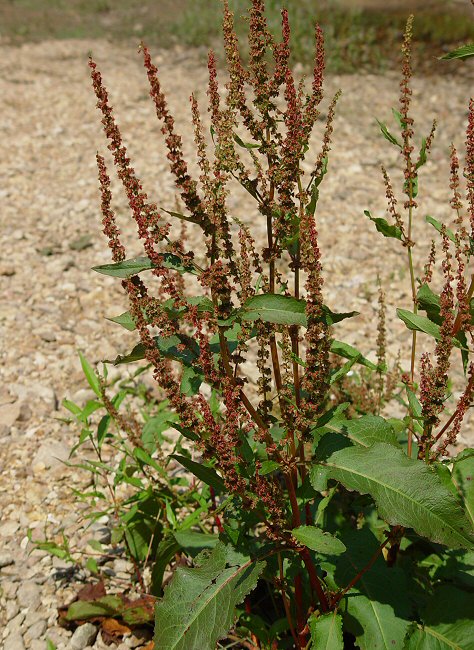Rumex obtusifolius L.
Bitter Dock

Introduced
CC = *
CW = -3
MOC = 30
© DETenaglia
Rumex obtusifolius L.Bitter Dock | |
 |
Introduced CC = * CW = -3 MOC = 30 |
© DETenaglia |
|
Family - Polygonaceae Habit - Perennial forb, with perfect flowers and a thickened, somewhat turnip-shaped, vertical rootstock. Stems - Arching, ascending, or erect, to 1.2 m, sometimes multiple from base, usually well-branched above the midpoint, glabrous or nearly so. Ocreae pale to light brown and papery, tearing and usually becoming deeply dissected or absent at maturity.
Leaves - Alternate, simple, petiolate. Basal leaves larger and usually longer-petiolate than the lower stem leaves. Blades of main leaves 20-40 cm long, 10-15 cm wide (mostly 2-4 times longer than wide), thick and often somewhat leathery, oblong to oblong-ovate, those of the uppermost leaves progressively shorter and narrower, unlobed, the margins entire or nearly so, flat or more commonly somewhat undulate and sometimes slightly crisped, angled (upper leaves) to truncate, rounded, or cordate at the base, rounded or bluntly pointed at the tip, the surfaces glabrous or the undersurface minutely hairy along the main veins.
Inflorescence - Terminal and axillary, usually occupying the upper 1/2-2/3 of the plant, narrowly to more broadly paniculate with ascending branches (diverging from the main axis at an angle of 30-45 degrees), relatively dense but interrupted toward the base. Flowers 10-25 per whorled fascicle, the stalks 5-10 mm long, mostly 2-3 times as long as the fruiting perianth, arched downward or nodding, jointed toward the base or rarely near the midpoint.
Flowers - Perfect. Tepals 6, in 2 whorls, these free, glabrous, green to greenish white at flowering, becoming brown to reddish at fruiting, mostly spreading at flowering, the inner whorl of 3 tepals becoming ascending, enlarged and with a prominent network of nerves at fruiting, 1 of the enlarged inner tepals developing a prominent, differentiated, central swelling (tubercle) at fruiting. Stamens 6, exserted, the anthers attached toward their bases, the filaments short, unwinged. Styles 3, free, the stigmas deeply divided into numerous slender lobes, appearing fringed. Fruits - Inner whorl of tepals becoming enlarged to 3-6 mm long and 2.0-3.5 mm wide (excluding the teeth) at fruiting, with relatively broad wings, ovate to ovate-triangular, truncate or very broadly angled at the base, sharply or bluntly pointed at the tip, each tepal with 4-8 conspicuous, sharp, sometimes spinelike teeth along the wing margins, these 0.5-1.8 mm long, mostly shorter than the width of the undivided portion, the surfaces with a prominent network of nerves; tubercle usually 1 (2 of the inner tepals lacking tubercles), rarely with 1 larger and 2 smaller tubercles, the largest covering 1/2 or more of the width of the tepal (including the wings but not the teeth), glabrous, smooth; the outer whorl spreading at fruiting. Fruits 2.0-2.7 mm long, 1.2-1.7 mm wide, brown to reddish brown.
Flowering - April - June. Habitat - Streambanks, bottomland forests, mesic upland forests in ravines, marshes, pastures, quarries, gardens, railroads, roadsides, disturbed areas. Origin - Native to Europe. Lookalikes - Other species of Rumex. Other info. - This big species can be found scattered in several Missouri counties, without much discernible regional pattern. Beyond Missouri it is likewise found in scattered fashion, occurring in most states of the continental U.S. Though many species of Rumex appear similar, this one is distinguished by its relatively wide, oblong leaves, and fruiting tepals having marginal spines and a single tubercle. Often, the veins of the lower leaves are red. The plant can grow in both shaded and open areas, and the nature of the habitat can influence the appearance to some degree. Photographs taken in Vale, NC., 3-15-03, and at Pultite Spring, MO., 6-27-04 (DETenaglia); also at Little Lost Creek Conservation Area, Warren County, MO, 7-8-2020 (SRTurner). |